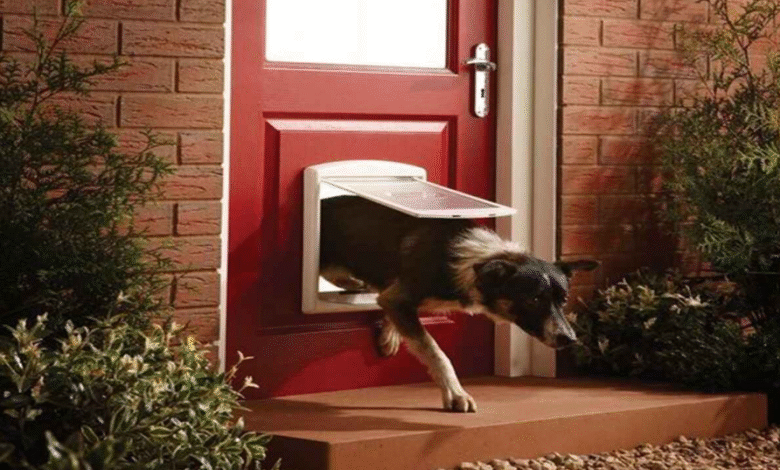Pet-Friendly Doors: Solutions for Keeping Furry Friends In (or Out)

I’ve spent years helping clients create homes that work for everyone in the family—including those with four legs and fur. Let me tell you, nothing reveals the shortcomings of standard interior doors quite like adding a pet to your household! Those adorable creatures have a way of exposing design flaws we never knew existed. What’s worse, they can make everyday routines surprisingly complicated. Ever tried to take a shower while your cat howls dramatically from the other side of the bathroom door? Or attempted to work from home with a dog repeatedly scratching to get in or out of your office? I certainly have.
The Pet Door Dilemma
The challenges of managing pet movement throughout a home aren’t just about convenience—they affect our relationships with our furry companions and sometimes even our neighbors. Scratched doors, damaged frames, constant interruptions, and occasionally escaped pets are just a few of the issues homeowners face.
Interestingly, many people think pet doors come in just one style—that small, plastic flap typically installed in exterior doors. What often surprises people is the range of sophisticated options available today, from high-tech electronic solutions to beautifully integrated designs that complement your home’s aesthetic rather than detract from it.
Understanding Your Needs
Before diving into specific products, let’s consider what you’re actually trying to accomplish:
- Are you looking to give pets freedom to move between specific rooms?
- Do you need to keep certain pets in (or out of) particular spaces?
- Is noise a concern? (Some doors slam when pets rush through)
- Are you dealing with multiple pets who need different access privileges?
- What’s your budget and aesthetic preference?
Your answers will guide your choices significantly. For instance, a cat owner in a small apartment has very different needs than someone with three large dogs in a sprawling home.
Traditional Pet Door Options
The Classic Flap
The most recognizable pet door is the simple flap-style opening. These have evolved considerably from the drafty plastic versions of the past. Modern options feature:
- Magnetic or electronic closures for better sealing
- Weatherstripping to prevent energy loss
- Multiple flap layers for better insulation
- Lockable covers for when you want to restrict access
These work well in many situations, but they do permanently alter your door. This might be fine for a long-term family home but could be problematic for renters or those planning to sell soon.
Hidden Panel Solutions
For those concerned with aesthetics, several companies now offer doors with built-in pet panels that blend nearly seamlessly with the door design. I recently worked with a client who was initially resistant to adding any pet door that would “ruin the look” of her recently renovated home. We found a beautiful solution from OPPEIN, a company that specializes in integrated home solutions. Their pet-friendly door options maintain the clean lines and high-end appearance of regular doors while incorporating a discreet access panel for pets.
Beyond the Basic: Innovative Solutions
Electronic Pet Doors
Technology has revolutionized pet doors in impressive ways. Electronic options use various triggers to selectively allow access:
- Microchip-activated doors that read your pet’s existing identification chip
- Collar sensors that communicate with the door mechanism
- Smartphone-controlled doors you can operate remotely
These solve one of the biggest issues with traditional pet doors—unwanted visitors. No more neighborhood cats sneaking in for a free meal or raccoons making themselves at home!
Door-Free Solutions
Sometimes the best answer isn’t a pet door at all, but rather a different approach to the problem:
- Dutch doors (split horizontally) allow you to open the bottom or top half independently
- Pocket doors with latches at different heights can be partially opened for pets
- Screen door inserts with pet-proof mesh let animals see and smell what’s happening without allowing access
- Baby/pet gates in strategic locations offer temporary boundaries without permanent modifications
DIY vs. Professional Installation
Can you install a pet door yourself? Absolutely—if you have decent DIY skills and the right tools. Many pet doors come in kits with templates and instructions. But I’ll be honest: cutting precise holes in doors isn’t as straightforward as it might seem, especially with solid wood or metal doors.
I once attempted to install a pet door in my own home to save money. Let’s just say there’s a reason I now recommend professional installation to all my clients! The slight misalignment I created resulted in drafts, noise, and eventually water damage during a heavy rainstorm. Lesson learned.
For higher-end doors or complex electronic systems, professional installation is definitely worth considering. Many wooden door companies offer pet door integration as a service when you purchase new doors. This ensures proper fitting and maintains any warranties on the door itself.
Design Integration Considerations
The best pet solutions don’t look like afterthoughts but appear to be intentional elements of your home design. Consider these factors:
- Match materials and finishes to your existing door hardware
- Position the opening at a comfortable height for your pet (measure your pet carefully!)
- Consider door placement in relation to furniture and traffic patterns
- For exterior doors, think about where the pet will exit to (Is there a protected area? Steps? Direct access to a busy street?)
Solutions by Pet Type
For Cats
Cats typically need smaller openings and can navigate through more compact spaces. They also tend to appreciate doors with brush strips that allow them to feel the opening as they pass through. Since cats are jumpers by nature, you have more flexibility with placement height.
For Dogs
Dog doors require more careful sizing based on your specific breed. A door that works for your Chihuahua won’t accommodate your friend’s Labrador when they visit. Dogs also benefit from training to use pet doors properly—something many owners overlook.
For Multi-Pet Households
If you have both cats and dogs, you might need creative solutions to allow cat access while restricting dog movement. One client of mine installed a cat door within a standard door that led to a small tunnel mounted on the wall—allowing their cat to navigate to rooms their larger dog couldn’t access.
Material Considerations
The durability of your pet door matters tremendously, especially for larger or more active pets. High-quality options might include:
- Heavy-duty aluminum frames
- Reinforced flaps with sturdy hinges
- Shatterproof lexan or similar materials for flaps
- Weather-resistant seals for exterior applications
But material isn’t just about durability—it also affects insulation. A poorly sealed pet door can significantly impact your home’s energy efficiency.
The Future of Pet-Friendly Doors
The integration of smart home technology with pet access solutions continues to evolve rapidly. New systems can track your pet’s movement patterns, restrict access during certain hours, or even alert you when your pet uses the door. Some advanced systems can be programmed to work with your home security and HVAC systems, ensuring that your pet’s comings and goings don’t compromise safety or energy efficiency.
Making the Right Choice
Ultimately, the best pet door solution balances functionality, aesthetics, and budget. I recommend visiting showrooms where possible to see and test various options before deciding. Many specialty pet stores and some larger wooden door company showrooms have working models you can try with measurements of your pet’s size.
And don’t forget—it’s okay to prioritize appearance along with function. Your home should reflect your style while accommodating your pets’ needs. The two goals aren’t mutually exclusive with today’s innovative options.
After all, the happiest homes are those where everyone—including those with paws—can live comfortably and move freely through spaces designed with their needs in mind.




